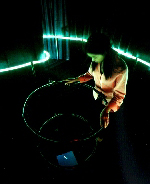|
Mori: an internet-based earthworkKen Goldberg, Randall Packer, Wojciech Matusik and Gregory KuhnBerkeley, California, USA ``All flesh is grass.'' -- Isaiah (40:6) In Mori, minute movements of the Hayward Fault in California are measured by a seismograph, converted to digital signals, and transmitted continuously via the Internet to a sound installation. Inside the entry curtain, visitors follow a fiber optic cable to the center of the resonating enclosure, where a portal through the floor frames the installation's focal point. An embedded visual display and immersive low-frequency sounds are modulated by the unpredictable fluctuations of the earth's movement. UC Berkeley's Streckeisen STS-1 Seismometer measures ground velocity in 3 orthogonal directions (X,Y,Z). A Quanterra Q935 datalogger digitizes the data stream, sending three 4-byte integer values 20 times per second (about 2kbps). This data stream is sent over dedicated lines to the UC Berkeley Seismological Laboratory. Memento.ieor.berkeley.edu, a Pentium II server UC Berkeley's IEOR Department, makes a socket connection to a machine at the station to receive the real time data stream. Memento also runs the Apache Internet server for the online visual interface, which distributes Java Applet to web clients. Client applets establish connections and receives continuous data streams, displayed as a ghostly monochromatic trace. Client displays are delayed 30 seconds due to buffering that provides visual continuity. At the sound installation, another PC receives seismographic data using a second data feed from the Seismological Lab. This PC runs a visual display at the installation and outputs data in MIDI format to a Macintosh G3. The G3, running the Cycling 74 MAX/MSP software, processes the signal to modulate environmental sound samples such as rockslides, volcanic eruptions, thunder claps, avalanches, and industrial noise. The installation houses a five-channel sound system, including a powerful sub-woofer beneath the floor that transmits sound through visitors' bodies. The sound is ``conducted'' by the live seismic data, including density, spectral characteristics, amplitude, and spatialization. The Z signal is used to shape the amplitude of the sound, creating a sonic waveform that is a direct analog of the visual display. The Z signal also filters the frequency mix to add visceral low frequency sound components. The X and Y signals are used to focus eruptive sounds at the center of the installation and to pan sounds from sustained samples through the space. Samples are slowed considerably to suggest reverberation deep within the earth. The fiber optic guiderail is illuminated by a metal halide lamp that is intermittedly obstructed by a wheel driven by a MIDI controlled stepper motor, so that high frequency flicker corresponds to large amplitude Z motion. Mori was selected for the ICC Biennial in Tokyo, and then exhibited as part of Telematic Connections, a travelling ICI show organized by Steve Dietz of the Walker Art Center. The title links the Japanese term for ``forest-sanctuary'' with the Latin ``reminder of mortality.'' In this internet-based earthwork, the immediacy of the telematic experience challenges the authenticity of media in the context of chance, human fragility, and geological endurance. The visual interface is online at: |
